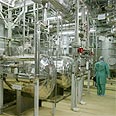
Report: Mossad assassinated Iranian nuclear scientist
Intelligence source suggests that a prize-winning nuclear physicist, who recently died in mysterious circumstances, was killed by Israeli security service, Sunday Times reports
An intelligence source has suggested that a prize-winning Iranian nuclear scientist had been assassinated by the Mossad, the Israeli security service, The Sunday Times reported.
Ardeshire Hassanpour, 44, a nuclear physicist, died in mysterious circumstances, according to Radio Farda, which is funded by the US State Department and broadcasts to Iran.
According to the Sunday Times, Hassanpour worked at a plant in Isfahan where uranium hexafluoride gas is produced. The gas is needed to enrich uranium in another plant at Natanz which has become the focus of concerns that Iran may be developing nuclear weapons.
According to Radio Farda, Iranian reports of Hassanpour’s death emerged on January 21 after a delay of six days, giving the cause as “gas poisoning”. The Iranian reports did not say how or where Hassanpour was poisoned but his death was said to have been announced at a conference on nuclear safety.
Rheva Bhalla of Stratfor, the US intelligence company, told the Sunday Times on Friday that Hassanpour had been targeted by Mossad and that there was “very strong intelligence” to suggest that he had been assassinated by the Israelis, who have repeatedly threatened to prevent Iran acquiring the bomb.
Journalists visit Isfahan plant
On Saturday, Iran opened the gates to the Isfahan key uranium conversion facility to visiting diplomats and journalists in an effort to show that its disputed nuclear program is peaceful and not a cover for nuclear bomb making.
The visit to the plant in central Iran was the first such tour since Iran resumed uranium conversion in August 2005. The UN Security Council slapped economic sanctions on Iran on December 23 over the country's refusal to halt uranium enrichment, which can be used for making weapons.
The visit also came ahead of a UN deadline for Iran to stop the enrichment. If Tehran doesn't comply by the end of the 60-day period stipulated by the UN, the Security Council will consider new measures beyond the economic sanctions.
The United States and several of its Western allies believe that Iran is using the nuclear program to produce an atomic weapon - charges Iran denies, saying its aim is to generate electricity.
The diplomats visiting the plant came from Sudan, Cuba, Egypt, Malaysia and Algeria. They represented the Arab League and two groups of developing nations known as the Nonaligned Movement and the G-77 - organizations that have asserted the rights of members to pursue national interests unfettered by Western countries.
The plant at Isfahan, 255 miles south of Tehran, is responsible for an early stage of the nuclear fuel cycle, turning yellowcake uranium into uranium hexaflouride gas, or UF-6, the feedstock for enrichment.
International concerns have recently focused more on the facility in Natanz, where uranium can be enriched using cascades of centrifuges. Only highly enriched uranium can be used for bomb-making.
But Iranian officials on Saturday's tour talked only of the program's peaceful purposes, which Iran is determined to pursue.
Ali Ashgar Soltanieh, head of Iran's delegation to the U.N. nuclear watchdog agency - the International Atomic Energy Agency - said the message of the visit was to show "that Iran is determined to continue its peaceful nuclear activities."
"This is an opportunity to see for yourselves what is going on and get first hand information about the activities here," Soltanieh told the diplomats and dozens of reporters.
The visitors saw several areas of the Isfahan facility, including two cameras installed by the IAEA to monitor activity where uranium gas is produced.
Soltanieh said the two cameras, which take photos every two minutes, are in place according to Iran's obligations under the Nonproliferation Treaty.
They are the only cameras at Isfahan. Iran removed others here when it stopped allowing the IAEA to conduct snap inspections, a measure it took after the agency referred it to the Security Council last February. IAEA inspectors visited the Isfahan facility twice in January.
Soltanieh said the tour was "an opportunity to see that the IAEA has full surveillance control over the activities of this facility."










